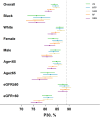Comparing methods for glomerular filtration rate estimation
- PMID: 40735118
- PMCID: PMC12305378
- DOI: 10.1017/cts.2025.10057
Comparing methods for glomerular filtration rate estimation
Abstract
Background: The glomerular filtration rate (GFR), estimated from serum creatinine (SCr), is widely used in clinical practice for kidney function assessment, but SCr-based equations are limited by non-GFR determinants and may introduce inaccuracies across racial groups. Few studies have evaluated whether advanced modeling techniques enhance their performance.
Methods: Using multivariable fractional polynomials (MFP), generalized additive models (GAM), random forests (RF), and gradient boosted machines (GBM), we developed four SCr-based GFR-estimating equations in a pooled data set from four cohorts (n = 4665). Their performance was compared to that of the refitted linear regression-based 2021 CKD-EPI SCr equation using bias (median difference between measured GFR [mGFR] and estimated GFR [eGFR]), precision, and accuracy metrics (e.g., P10 and P30, percentage of eGFR within 10% and 30% of mGFR, respectively) in a pooled validation data set from three additional cohorts (n = 2215).
Results: In the validation data set, the greatest bias and lowest accuracy, were observed in Black individuals for all equations across subgroups defined by race, sex, age, and eGFR. The MFP and GAM equations performed similarly to the refitted CKD-EPI SCr equation, with slight improvements in P10 and P30 in subgroups including Black individuals and females. The GBM and RF equations demonstrated smaller biases, but lower accuracy compared to other equations. Generally, differences among equations were modest overall and across subgroups.
Conclusions: Our findings suggest that advanced methods provide limited improvement in SCr-based GFR estimation. Future research should focus on integrating novel biomarkers for GFR estimation and improving the feasibility of GFR measurement.
Keywords: GFR; equation; estimation; performance; serum creatinine.
© The Author(s) 2025.
Conflict of interest statement
KCN is a Kidney Disease Quality Improvement Consultant for Atlantis Health, Inc.
Figures




Similar articles
-
Adoption of CKD-EPI (2021) for Glomerular Filtration Rate Estimation: Implications for UK Practice.Nephron. 2025;149(3):133-148. doi: 10.1159/000541689. Epub 2024 Sep 28. Nephron. 2025. PMID: 39342928 Free PMC article.
-
Performance of race-neutral eGFR equations in patients with decompensated cirrhosis.Liver Transpl. 2025 Feb 1;31(2):170-180. doi: 10.1097/LVT.0000000000000410. Epub 2024 May 31. Liver Transpl. 2025. PMID: 38814160 Free PMC article.
-
Assessing Renal Function in Chronic Kidney Disease: A Comparative Evaluation of Glomerular Filtration Rate Prediction Equations in the North-Central Region of Nigeria.Cureus. 2025 May 21;17(5):e84577. doi: 10.7759/cureus.84577. eCollection 2025 May. Cureus. 2025. PMID: 40546627 Free PMC article.
-
Comparison of glomerular filtration rate estimating equations in older adults: A systematic review and meta-analysis.Arch Gerontol Geriatr. 2023 Nov;114:105107. doi: 10.1016/j.archger.2023.105107. Epub 2023 Jun 17. Arch Gerontol Geriatr. 2023. PMID: 37379796
-
Estimating equations for glomerular filtration rate in the era of creatinine standardization: a systematic review.Ann Intern Med. 2012 Jun 5;156(11):785-95. doi: 10.7326/0003-4819-156-11-201203200-00391. Epub 2012 Feb 6. Ann Intern Med. 2012. PMID: 22312131
References
LinkOut - more resources
Full Text Sources
Research Materials
Miscellaneous
